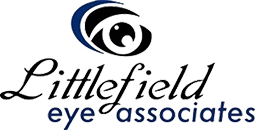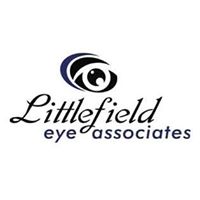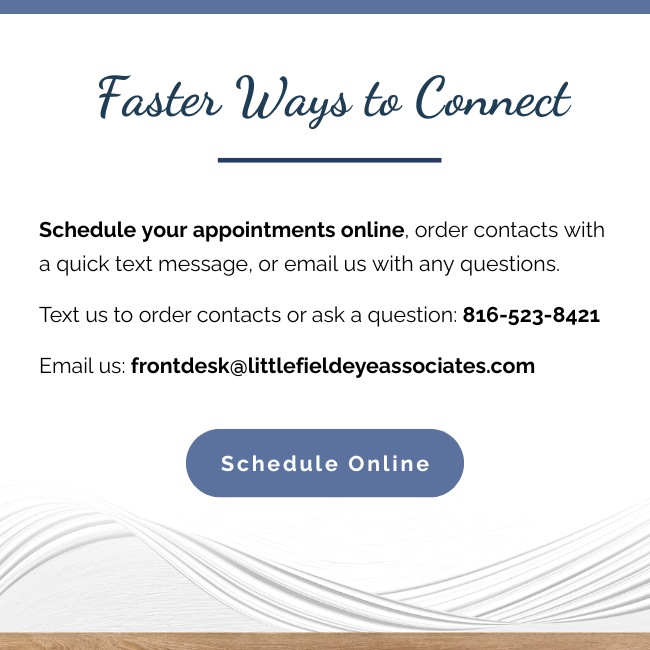Dry eye disease is an uncomfortable condition that affects over 16 million Americans. Many people think that dry eye disease is only a minor eye problem, but it’s a severe condition that can lead to vision problems if left untreated.
Dry eye disease occurs when the tear glands in your eyes fail to produce enough tears or your tears evaporate too quickly, leading to discomfort and inflammation. Your optometrist at Littlefield Eye Associates can examine your symptoms during an eye exam and help you find relief from this common condition.
What Causes Dry Eye Disease?
When we discuss dry eyes, we’re talking about the health of your tear film. Your tears have a lot going on beneath the surface, and every time you blink, they spread across your eye to help it stay healthy and hydrated.
3 layers make up your tear film:
- An inner mucus layer to help stabilize your tears and provide a smooth surface.
- A watery middle layer that helps hydrate your eyes while repelling bacteria.
- An outer oily layer that helps stop the other layers from evaporating too soon.
There are 2 types of dry eye disease, each with its own causes: aqueous deficiency dry eye and evaporative dry eye.
Aqueous deficiency dry eye can occur when you aren’t producing enough tears to keep your eyes hydrated. We generally produce fewer tears as we age, which is why dry eyes can be common in people over 50.
Problems with tear production could also be a symptom of a separate medical condition, such as Sjögren’s syndrome. However, aqueous deficiency dry eye only accounts for a tenth of dry eye cases.
Evaporative dry eye is much more common and is often caused by meibomian gland dysfunction (MGD). Your meibomian glands are responsible for creating your tear film’s oily layer. If they become blocked or inflamed, your tears may evaporate too fast, leading to dryness.
Risk Factors for Dry Eyes
Factors that can increase your risk of developing dry eye disease include:
- Age
- Biological sex
- Windy, smoky, hot, or dry environments
- Some medications, such as antihistamines, decongestants, and antidepressants
- Some medical conditions, such as Sjogren’s syndrome, rheumatoid arthritis, and diabetes
- Poor diet
- Excessive screen time
What Are the Symptoms of Dry Eye Disease?
Dry eye symptoms can range from mild to severe depending on the underlying causes and your response to the condition. Common symptoms include:
- Eye discomfort and irritation
- A burning or stinging sensation
- Redness
- Sensitivity to light
- Blurry vision
- The feeling of something being stuck in your eye
You could even experience watery eyes, which may seem like a good thing. Unfortunately, if your tears evaporate too quickly because of something like MGD, those extra tears may not offer any relief.
Dry eye disease can leave your eyes without your tear film’s protective shell, which could allow proteins and other debris to build up on your eyes and potentially damage your corneas, your eyes’ clear front dome.

How Do You Treat Dry Eye Disease?
Dry eye disease is a chronic condition that may require ongoing management. Your eye doctor can help you control your symptoms, offering treatments that can help keep your eyes healthy, comfortable, and seeing clearly.
Some of the treatments we offer at Littlefield Eye Associates include:
- Artificial tears: Lubricating eye drops can reduce redness and soothe dry eye symptoms. These can even be an option if you wear contact lenses, though you should talk to your eye doctor about a brand that won’t damage your lenses.
- Medical eye drops: Depending on the type of dry eyes affecting you, we might recommend anti-inflammatory drops to help soothe your eyes.
- Nutritional supplements: Some studies have shown that omega-3 fatty acids can assist in maintaining a healthy tear film. You can find these nutrients in fish, but supplements such as fish oil can combat a deficit in your diet. Always talk to your doctor before taking supplements.
IPL Treatment for Dry Eyes
IPL stands for intense pulsed light, and it’s a treatment that has been used in dermatology for cosmetic purposes, such as treating sunspots and facial hair removal.
Optometrists that specialize in dry eye treatment, like the doctors at Littlefield Eye Associates, are beginning to offer IPL treatment as part of dry eye therapy.
During an IPL treatment, we use a specialized device to expose your eyelids to pulses of light that can stimulate your meibomian glands and reduce surrounding inflammation. Since these glands are responsible for the oily layer that helps keep your tear film stable, keeping them unblocked and healthy is vital for avoiding dry eyes.
IPL treatment can melt away gland blockages and encourage healthy oil production. An average IPL treatment is 10–15 minutes, and a full treatment plan could consist of 4 or more treatments spaced 3–4 weeks apart.
Not only can IPL bring hydration back to your eyes, but it also can prevent symptoms from reoccurring. We may recommend maintenance treatments to help you continue avoiding dry eye symptoms.
Dry Eye Prevention
It’s possible to prevent or reduce dry eye symptoms by adopting healthy habits, including the following:
- Drink plenty of water to stay hydrated
- Add a humidifier to your bedroom or workspace
- Blink frequently while working on a computer and use the 20-20-20 rule
- Wear sunglasses to protect your eyes from the sun and wind
Say Goodbye to Dry Eyes
Dry eyes can be frustrating, but your symptoms don’t have to be permanent. Littlefield Eye Associates is proud to offer OptiLight by Lumenis to our patients, specially designed for dry eye management. OptiLight by Lumenis is a light-based, non-invasive treatment done in the area below the eyes to manage dry eye. The first and only IPL FDA-approved for dry eye management.
If you think you may have dry eye disease but you’re not sure, take our questionnaire to learn if you could benefit from a checkup.
Don’t let your eyes suffer in silence. Book an appointment today and ask us about OptiLight by Lumenis or any of our other dry eye treatments.





